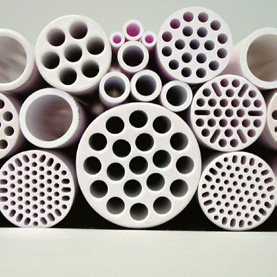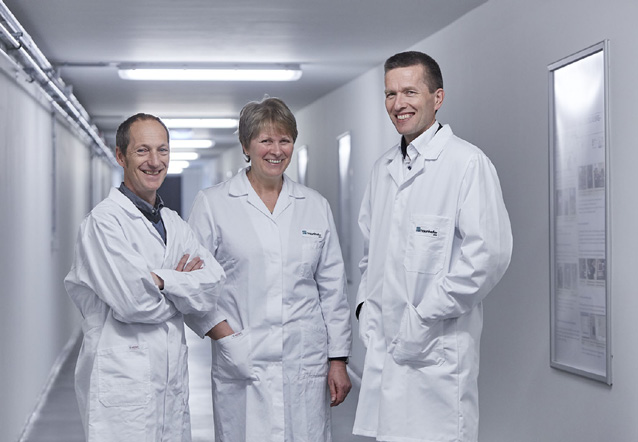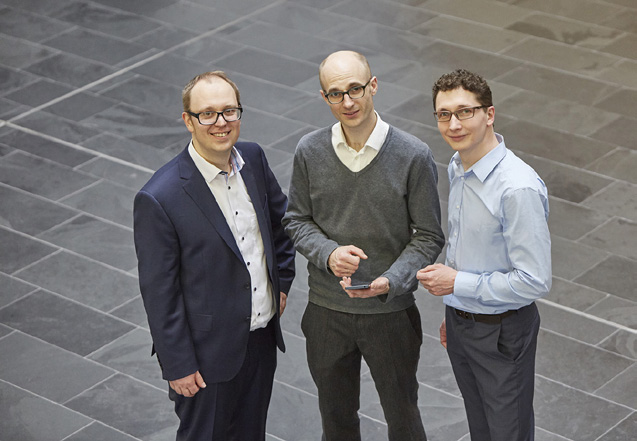Joseph von Fraunhofer Prize: double success for Group institutes
Not one but two institutes within the Group for Microelectronics were able to impress this year’s jury of the Joseph von Fraunhofer Prize in two different areas – they were Fraunhofer IIS and Fraunhofer IKTS. The awards went to a new codec for improved voice quality in mobile telephony and a nano-filtration membrane for sustainable water purification.


Water is not only vital to the survival of the organism, but also plays an important role in a wide range of everyday processes – whether in the home or in industry. Water consumption continues to increase, but this invaluable resource is not inexhaustible. This highlights how important it is to purify and reuse service and waste water. Ceramic membranes offer a good opportunity to do just that: as they use a mechanical separation process – much like a coffee filter – they are particularly energy-efficient. Until now, however, this method has reached its limitations at a molecule size of 450 daltons.
Molecules only 200 daltons in size separated for the first time
Researchers at the Fraunhofer Institute for Ceramic Technologies and Systems IKTS have now moved this boundary a considerable distance: the team led by Dr. Hannes Richter, Petra Puhlfürss, and Dr. Ingolf Voigt has achieved a molecular separation limit of 200 daltons using the nano-filtration membrane they developed – achieving an entirely new quality of wastewater purification. The innovative ceramic membranes also offer advantages to industrial production processes: they can be used to clean partial streams directly within the process, after which the purified water can be run in circulation – this saves water and energy. “The design challenge laid in producing a membrane with small enough pores that even the tiniest molecules could be reliably separated. To do so, all pores need to be as close to the same size as possible, as a single larger opening is enough to let molecules escape. A modification to the sol-gel technique enabled us to achieve this,” according to Dr. Hannes Richter, department head at Fraunhofer IKTS.
Transfer from the lab to practical application
The second hurdle was to make membrane layers of this type that would be free of defects even over larger areas. Although usually only areas of a few square centimeters are coated, the IKTS-researchers set up a pilot system with a membrane area of 234 m² for their development. This system was commissioned by Shell and built by Andreas Junghans – Anlagenbau und Edelstahlbearbeitung GmbH & Co. KG in Frankenberg, and is located in the Canadian province of Alberta. Since 2016, the system has been successfully cleaning waste water that is used for extracting oil from tar sands. The researchers are currently planning the first production system, with a membrane area of more than 5000 m². The jury of the Joseph von Fraunhofer Prize recognized the first implementation of this idea for filtration purposes in this material class by awarding the coveted prize.


Voice quality like being face to face
In a completely different category, another research team from a Fraunhofer Microelectronics institute did well this year: Markus Multrus, Dr. Guillaume Fuchs, and Stefan Döhla from the Fraunhofer Institute for Integrated Circuits IIS, together with a team of around 50 researchers and engineers, have developed a new codec that is intended to considerably improve voice quality in mobile phone calls. As far as functionality goes, modern smartphones can almost match a PC – but voice calls have been left out of recent leaps in innovation and their quality has been at the same level for decades.
The new standard, Enhanced Voice Services, or EVS for short, is set to change that: instead of a hollow, distorted call quality, the new technology allows users to hear the other person’s voice as clearly and naturally as if they were speaking face to face. The codec was initiated and developed by the international mobile communication standardization committee 3rd Generation Partnership Project (3GPP). A large team from Fraunhofer IIS in Erlangen made a significant contribution to the project. The demands placed on a standard of this kind are high. The basic requirement is firstly to transmit voice calls in significantly higher quality than before – while keeping data rates low, to ensure that transmission remains economical. Furthermore, the codec needs to be robust against transmission errors. This ensures that the call is not interrupted in bad reception conditions. The codec also needs to be able to handle other signals well – and to transmit hold music in good sound quality, for example. However, this is not that simple, as voice and audio coding are two different worlds. That is why the codec performs an analysis 50 times per second to check whether voice or music is currently being transmitted – and applies the appropriate algorithms in each case.
Transmitting the entire audible frequency spectrum
But what exactly is the technical difference between existing codecs and EVS? “The human ear can perceive frequencies of up to 20 kHz,” explains Guillaume Fuchs, who drove forward the scientific development of EVS at Fraunhofer IIS. “The existing codec can only transmit sound signals in a frequency range of up to 3.4 kHz – the range between 3.4 and 20 kHz is simply cut off. That is why the voice sounds hollow. Depending on the bit rate, the new codec can transmit frequencies of up to 16 or even 20 kHz.” In short, the codec covers the complete audible frequency spectrum – at data rates that are comparable with existing mobile communication codecs.
No different from natural speech
The codec has been evaluated by several thousand test listeners in numerous tests around the world. The result: listeners deemed the new standard to be significantly better than the existing processes. The codec has now been standardized within 3GPP; according to estimates, 50 to 100 million devices have already been equipped with EVS, including in Japan, Korea, the USA, and Germany. With this success, the Erlangen-based researchers were also able to win over the jury of the Joseph von Fraunhofer Prize. The jury based its decision to award the prize on factors including “the worldwide use and the high expected licensing revenues.”
Since 1978, the Fraunhofer-Gesellschaft has awarded the Joseph von Fraunhofer Prize annually for its researchers’ outstanding scientific achievements that solve applicationoriented problems. This year, four prizes were awarded, each worth €50,000.
Last modified: